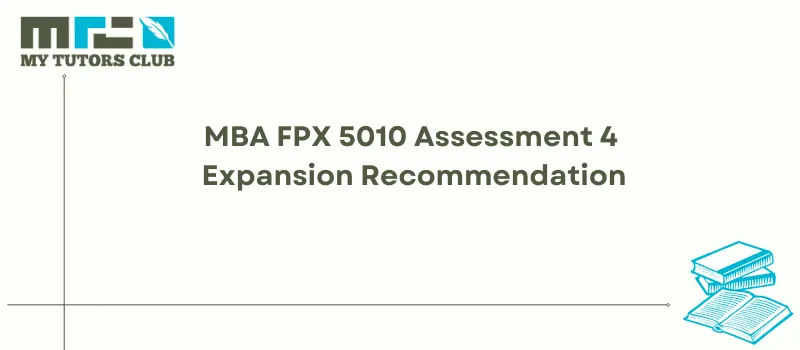Overview of the Expansion Recommendation
The expansion recommendation evaluates the feasibility and benefits of continuing and launching new processes within XYZ Company. The objective is to analyze financial data, potential risks, and expected profitability to determine whether the proposed expansion plan aligns with the company’s strategic goals.
Analysis of Financial Statements
The financial records of XYZ Company provide insights into key parameters, including revenue trends and profit margins. By conducting a strategic evaluation and forecastingMBA FPX 5010 Assessment 4 Expansion Recommendation financial outcomes, we aim to present a clear understanding of the company’s financial position and identify opportunities for successful expansion.
Gross Profit Examination
The financial analysis strongly supports the expansion initiative. The gross profit for the first year is estimated at $583,040; over the next ten years, it is projected to reach $33,164,007. This consistent upward trend highlights the company’s ability to generate substantial gross profit, demonstrating the expansion’s feasibility and profitability (CFI, 2023). The positive gross profit margin reinforces the potential for significant financial returns, making this project a sound investment for XYZ Company.
Net Income Review
The initial year of the expansion shows a net loss of ($73,357) due to start-up costs and fixed expenditures. However, projections reveal a net income of $17,339,027 over ten years. While the early phase may seem challenging, focusing on the long-term outlook reveals a strong upward trajectory toward profitability. This trend underscores the expansion’s ability to deliver sustainable financial gains (CFI, 2023b).
Cash Flow Analysis
Although cash flow is negative in the first year at ($42,733) due to start-up expenses, it transitions into a positive flow over the ten-year projection, aligning with net income growth. The anticipated cash flow for the decade totals $17,339,027 (Loth, 2023). Proper financial management and resource optimization will play a key role in maintaining positive cash flow, ensuring the long-term success of the expansion.
Potential Risks
Market Risk
Due to economic uncertainty and fluctuating customer demand, market risk remains a significant factor. Since XYZ Company operates in a niche industry, any economic downturn or reduced interest in its products could directly affect revenue and profitability. Such market volatility highlights the need for contingency plans to address potential challenges (Tamplin, 2023).
Operational Risk
Operational risks stem from workflow discrepancies and dependencies within the company. For instance, XYZ Company’s reliance on a single supplier for critical components could disrupt production if supply chain issues arise. Additionally, regulatory changes, such as stricter environmental policies or increased import taxes, could escalate costs and affect profit margins (Chapelle, 2019).
Despite these risks, the analysis reveals that they are manageable with accurate planning and efficient workflows. While slight deviations in projections could impact future returns, sound risk management practices will help mitigate these challenges and safeguard profitability.
Recommended Course of Action
Based on the financial analysis and risk assessment, the recommended course of action is to proceed with XYZ Company’s expansion plan. Projections indicate stable revenue growth for both products, with annual sales expected to reach $3,900,000 for Product A and $5,500,000 for Product B by Year 7. This growth highlights strong market demand and a promising future for the company.
MBA FPX 5010 Assessment 4 Expansion Recommendation
Even though Year 1 shows a net deficit of $73,357, net income is projected to rise to $4,385,039 by Year 10 (ClearTax, 2021). The total cash flow remains positive over ten years, further validating the expansion’s financial sustainability. The proposed investment of $7,000,000 is justified by a positive Net Present Value (NPV) of $3,985,000 and a solid Return on Investment (ROI) of approximately 12%.
Financial Criteria Support
Financial metrics such as NPV and ROI confirm the feasibility and profitability of the expansion project. While initial costs contribute to Year 1’s negative cash flow, the cumulative net cash flow over ten years is projected at $17,339,027. This positive trend underscores the project’s long-term value and aligns with XYZ Company’s financial objectives (Birken, 2022).
The projected ten-year revenue of $56,840,000 reflects growing customer interest and strong market performance. Precisely, revenue for Product A is forecasted at $34,640,000 and Product B at $22,200,000, further highlighting the expansion’s alignment with customer demand.
Gross Profit and Sustainability
The gross profit analysis reveals consistent growth, with initial gross profit reaching $583,040 and increasing steadily over the years. This trend confirms the project’s ability to sustain profitability and generate reliable income streams. The analysis also demonstrates that the initial investment will be recoverable within a reasonable timeframe, enhancing the company’s financial stability (Birken, 2022).
Conclusion
In conclusion, the financial evaluation and risk analysis strongly support XYZ Company’s expansion plan as part of MBA FPX 5010 Assessment 4. Positive financial ratios, including a robust NPV and ROI and projected revenue and cash flow growth, validate the plan’s feasibility. While initial start-up costs present short-term challenges, the long-term benefits outweigh these concerns.
XYZ Company must closely monitor risks, market conditions, and operational workflows to ensure continued success. By implementing this expansion strategy, the company can strengthen its market position, drive profitability, and achieve sustainable growth in the years ahead.




